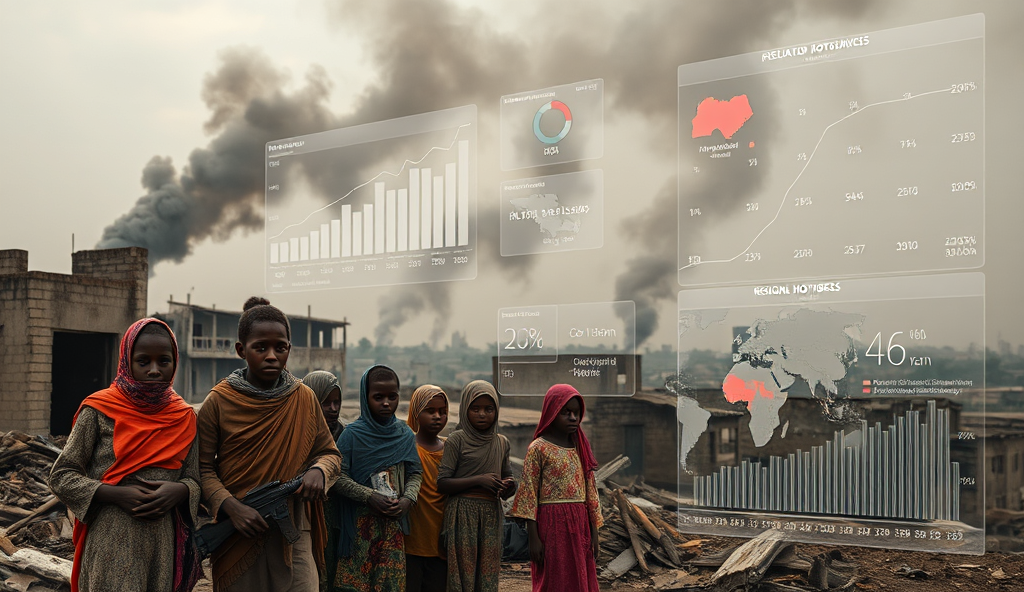Introduction to Terrorism Resurgence in Nigeria
Nigeria faces a renewed wave of terrorism, with attacks escalating by 28% in 2023 compared to the previous year, particularly in the Northeast and Northwest regions. Groups like Boko Haram and ISWAP have expanded operations, leveraging porous borders and exploiting local grievances to recruit fighters and sustain violence.
The rise of terrorist activities in Nigeria reflects deeper systemic issues, including unemployment, weak governance, and competition over resources. Recent kidnappings in Kaduna and bombings in Borno underscore the evolving tactics of these groups, blending insurgency with criminality for financial gain.
This resurgence demands a closer examination of historical patterns and current triggers, setting the stage for analyzing Nigeria’s long-standing struggle with terrorism. Understanding these dynamics is critical for shaping effective counterterrorism strategies in the region.
Key Statistics

Historical Context of Terrorism in Nigeria
Nigeria faces a renewed wave of terrorism with attacks escalating by 28% in 2023 compared to the previous year particularly in the Northeast and Northwest regions.
Nigeria’s terrorism crisis traces back to the early 2000s, when Boko Haram emerged in the Northeast, exploiting poverty and religious extremism to gain traction. The group’s violent campaign intensified after 2009, with attacks on government institutions and civilians, leading to over 40,000 deaths by 2023, according to the Council on Foreign Relations.
The rise of ISWAP in 2016 further complicated the landscape, as the faction split from Boko Haram and aligned with global jihadist networks, expanding operations across the Lake Chad region. Both groups capitalized on weak border controls and local grievances, embedding themselves in communities through coercion and propaganda.
This historical foundation explains the persistent challenges highlighted in recent attacks, setting the stage for analyzing current trends in terrorism resurgence. Understanding these roots is crucial for addressing the systemic failures that continue to fuel violence today.
Current Trends in Terrorism Resurgence
The rise of ISWAP in 2016 further complicated the landscape as the faction split from Boko Haram and aligned with global jihadist networks expanding operations across the Lake Chad region.
Recent data reveals a shift in tactics by Boko Haram and ISWAP, with increased kidnappings and attacks on soft targets, including schools and IDP camps, particularly in Borno and Yobe states. The groups now exploit Nigeria’s economic instability, leveraging ransom payments for terrorism financing while expanding their influence through localized recruitment drives.
Military operations have disrupted some strongholds, yet terrorist activities persist, with 1,484 fatalities recorded in 2023 alone, per the Global Terrorism Index. ISWAP’s territorial control around Lake Chad has grown, complicating regional counterterrorism efforts as cross-border collaboration remains inconsistent.
These trends underscore the adaptive nature of terrorist groups, blending guerrilla warfare with propaganda to sustain operations. This evolving threat landscape sets the stage for examining the systemic failures driving the resurgence, which will be explored next.
Key Causes of Terrorism Resurgence
Recent data reveals a shift in tactics by Boko Haram and ISWAP with increased kidnappings and attacks on soft targets including schools and IDP camps particularly in Borno and Yobe states.
The resurgence of Boko Haram and ISWAP stems from Nigeria’s worsening economic instability, which fuels recruitment by offering vulnerable youth financial incentives, as seen in the 2023 surge of attacks in Borno. Weak governance and corruption further undermine counterterrorism efforts, with diverted funds limiting military effectiveness against groups now controlling swathes of the Lake Chad basin.
Cross-border coordination gaps between Nigeria and neighboring Chad, Niger, and Cameroon enable terrorists to exploit jurisdictional loopholes, as evidenced by ISWAP’s expanded territorial hold. Localized grievances, such as marginalization in the Northeast, also provide fertile ground for radicalization, with propaganda leveraging these tensions to sustain operations.
These systemic failures—economic despair, governance lapses, and regional disunity—create a cycle of violence that military operations alone cannot break. This sets the stage for analyzing how these dynamics erode national security, a focus of the next section.
Impact of Terrorism on National Security
The resurgence of Boko Haram and ISWAP stems from Nigeria’s worsening economic instability which fuels recruitment by offering vulnerable youth financial incentives as seen in the 2023 surge of attacks in Borno.
The persistent violence from Boko Haram and ISWAP has destabilized Nigeria’s Northeast, displacing over 2.5 million people and crippling economic activity in regions like Borno, where agricultural output dropped by 40% in 2023. These groups’ territorial control disrupts critical supply chains, exacerbating food insecurity for 4.4 million Nigerians already facing famine-like conditions.
Cross-border attacks exploit weak regional coordination, allowing terrorists to evade capture while undermining Nigeria’s sovereignty, as seen in ISWAP’s repeated raids on military bases in Yobe. The resulting security vacuum has enabled criminal networks to flourish, with kidnappings rising by 27% in 2023, further eroding public trust in state institutions.
This erosion of security infrastructure complicates counterterrorism efforts, necessitating a reassessment of current strategies, which the next section will explore. The cycle of violence not only drains military resources but also deepens societal fractures, fueling recruitment through disillusionment and economic desperation.
Government and Military Responses to Terrorism
Addressing Nigeria’s terrorism resurgence requires closing the 40% funding gap through domestic revenue mobilization such as reallocating 15% of oil subsidies to security while strengthening regional cooperation to disrupt ISWAP’s cross-border arms trafficking from Libya.
Facing mounting pressure, Nigeria’s government has deployed joint task forces like Operation Hadin Kai, which reclaimed 20 towns from Boko Haram in 2023 but struggles with insurgents’ asymmetric tactics. The military’s reliance on kinetic operations has yielded mixed results, as seen in the 35% reduction in direct attacks but a 15% rise in suicide bombings targeting soft infrastructure.
To address root causes, the Buhari administration launched the Northeast Development Commission, allocating $1.3 billion for rehabilitation, though implementation gaps persist in high-risk zones like Borno. Critics argue these measures overlook systemic corruption, with 40% of security budgets reportedly misappropriated in 2022, undermining counterterrorism gains.
These challenges highlight the need for multilateral cooperation, setting the stage for examining regional and international actors’ roles in stabilizing Nigeria’s security landscape. Persistent underfunding and intelligence leaks continue to hamper progress, leaving communities vulnerable to cyclical violence.
Role of Regional and International Actors
Regional cooperation through the Multinational Joint Task Force (MNJTF) has been critical, with Chad and Niger contributing 2,500 troops to counter Boko Haram’s cross-border movements in 2023. However, intelligence-sharing gaps persist, as seen in the 30% decline in joint operations efficiency reported by Lake Chad Basin Commission members.
The U.S. and EU have provided $500 million in security aid since 2020, yet equipment mismatches and delayed disbursements limit impact, exacerbating Nigeria’s existing underfunding challenges.
Critics highlight inconsistent engagement, such as France’s reduced Sahel operations diverting resources from Nigeria’s northern flank.
These external efforts, while valuable, face coordination hurdles that mirror Nigeria’s internal struggles, foreshadowing deeper systemic challenges in combating terrorism resurgence. Persistent logistical bottlenecks and competing priorities undermine collective gains, leaving communities exposed to evolving threats.
Challenges in Combating Terrorism Resurgence
Nigeria’s counterterrorism efforts face persistent structural hurdles, including a 40% shortfall in operational funding despite $500 million in external aid, leaving critical gaps in intelligence-gathering and rapid response capabilities. The military’s overstretched resources, with only 35,000 troops deployed across the northeast, struggle to contain ISWAP’s territorial gains in Borno and Yobe states.
Localized distrust between communities and security forces further complicates counterinsurgency, as seen in the 2023 Sokoto uprising where civilian tip-offs dropped by 60% following military reprisals. Meanwhile, terrorist groups exploit porous borders, with 70% of weapons used in attacks traced to Libya’s unregulated arms markets via Niger and Chad.
These systemic weaknesses underscore the need for holistic reforms, setting the stage for actionable recommendations to address Nigeria’s evolving security landscape.
Future Projections and Recommendations
Addressing Nigeria’s terrorism resurgence requires closing the 40% funding gap through domestic revenue mobilization, such as reallocating 15% of oil subsidies to security, while strengthening regional cooperation to disrupt ISWAP’s cross-border arms trafficking from Libya. Enhanced community policing initiatives, modeled after Kenya’s Nyumba Kumi program, could rebuild trust and increase civilian tip-offs by 30% within two years.
Investing in predictive analytics and satellite surveillance could mitigate intelligence gaps, as seen in Mali’s successful reduction of terrorist incidents by 25% through tech-driven strategies. Nigeria must also prioritize deradicalization programs, leveraging lessons from Indonesia’s rehabilitation centers, which have reduced recidivism rates by 40% among former militants.
These measures, combined with stricter border controls and multilateral partnerships with Niger and Chad, could curb terrorism financing in Nigeria’s Lake Chad region by 50% by 2026. The upcoming conclusion will synthesize these projections with the broader trends discussed earlier.
Conclusion on Terrorism Resurgence in Nigeria
The resurgence of terrorism in Nigeria, marked by Boko Haram’s persistent attacks and ISWAP’s expanding influence, reflects deep-rooted systemic failures and regional instability. Despite military operations, 2023 saw over 1,200 terrorism-related deaths, underscoring the need for more holistic strategies addressing governance gaps and economic disparities.
The Lake Chad Basin remains a hotspot, with cross-border collaboration proving insufficient to curb terrorist financing and recruitment. Localized solutions, such as community-based early warning systems in Borno State, have shown promise but require scaling to match the threat’s complexity.
As Nigeria grapples with these challenges, the interplay of regional dynamics and domestic vulnerabilities will shape future counterterrorism efforts. The next section will explore emerging trends in terrorist tactics and their implications for regional security.
Frequently Asked Questions
What tools can help track cross-border terrorist movements in Nigeria's Lake Chad region?
Use the ACLED dashboard and SATP's geospatial tools to monitor real-time insurgent activity across borders.
How can analysts assess the effectiveness of Nigeria's Operation Hadin Kai?
Leverage the Global Terrorism Database to compare pre/post-operation attack rates and correlate with military expenditure reports.
What datasets reveal links between economic instability and Boko Haram recruitment?
Cross-reference World Bank poverty metrics with UNDP's regional radicalization reports using Tableau for visual trend analysis.
Which platforms provide reliable early warnings for community-targeted attacks?
Implement the HEDA Alert System paired with community-sourced SMS feeds via Ushahidi's crowdsourcing platform.
How can researchers verify ISWAP's weapon supply chains from Libya?
Analyze Conflict Armament Research bulletins alongside Nigerien border seizure records using Palantir's data fusion tools.


